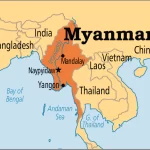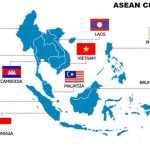
Regionalism
Regionalism is an ideology and political movement that seeks to advance the causes of regions. As a process it plays role within the nation as well as outside the nation i.e. at international level.
At the international level, regionalism refers to transnational cooperation to meet a common goal or to resolve a shared problem or it refers to a group of countries such as-Western Europe, or Southeast Asia, linked by geography, history or economic features.
The second meaning of the term is regionalism at national level refers to a process in which sub-state actors become increasingly powerful, power devolves from central level to regional governments. These are the regions within country, distinguished in culture, language and other socio-cultural factors.
Regionalism within nation
If the interest of one region or a state is asserted against the country as a whole or against another region/state in a hostile way, and if a conflict is promoted by such alleged interests, then it can be called as regionalism.
If someone is aspiring to or make special efforts to develop one’s state or region or to remove poverty & make social justice there, then that cannot be called as regionalism. Regionalism doesn’t means defending the federal features of the constitution. Any demand for separate state, autonomous region or for devolution of power below the state level is also, sometimes confused as regionalism.
Regionalism in INDIA
Roots of regionalism is in India’s manifold diversity of languages, cultures, ethnic groups, communities, religions and so on, and encouraged by the regional concentration of those identity markers, and fueled by a sense of regional deprivation. For many centuries, India remained the land of many lands, regions, cultures and traditions.
Regionalism in Politics
Regionalism has remained perhaps the most potent force in Indian politics ever since independence (1947), if not before.
- First, in the 1950s and 1960s, intense (ethnic) mass mobilisation, often taking on a violent character, was the main force behind the state’s response with an institutional package for statehood. Andhra Pradesh in India’s south showed the way. The fast unto death in 1952 of the legendary (Telugu) leader Potti Sriramulu for a state for the Telegu-speakers out of the composite Madras Presidency moved an otherwise reluctant Jawaharlal Nehru, a top nationalist leader and it was followed by State reorganisation commission under Fazal Ali paving way for State Reorganization Act, 1956.
- Second, in the 1970s and 1980s, the main focus of reorganization was India’s North-east. The basis of reorganization was tribal insurgency for separation and statehood. The main institutional response of the Union government was the North-eastern States Reorganisation Act, 1971.
- Third, the movements for the three new states (created in 2000)—Chhattisgarh out of Madhya Pradesh, Jharkhand out of Bihar and Uttaranchal out of Uttar Pradesh
Potential cause for regionalism:
- culturally dominated or discriminated against.
- Regional economic inequality is a potent time bomb directed against national unity and political stability. But, this potential cause did not take shape of regionalism, because of government steps, which focussed on the balanced regional development and fulfilled the aspiration of states.
- Few of them are – Industrial Policy, 1956, National Integration council, 1961. Transfer of financial resources to poorer states on the recommendation of Finance commission.
Government Preventive Steps
- Balanced Regional Development
- Categorisation of states on the basis of socio-economic backwardness.
- Regular public investment by central government through centrally sponsored schemes
- Government at centre and states give incentives to private players to develop in backward states through subsidies, taxation, etc.
- Nationalisation of banks, granting new banking licences
Why regional disparity still persists?
- Low rate of economic growth
- Socio-economic and political organisation of states
- Lower level of infrastructural facilities in backward states: The level of infrastructural development, such as- power distribution, irrigation facilities, roads, modern markets for agricultural produce has been at back stage. All these are state list subjects.
- Low level of social expenditure by states on education, health and sanitation — also regional imbalance in doing so (TN is a much better performer)
- Political and administration failure
- “Son of the soil”
Why son of the soil?
There remains a competition for job between migrant and local educated middle class youth.
Clashes in India having colours of regionalism
- Linguistic Reorganization of States
- Andra Pradesh and hunger strike
- Demand for Dravida Nadu
- Telangana Movement
- Shiv Sena against Kannadigas
- Bodoland Demand within Assam
- Khalistan Movement
- Attacks on Bihar Labourers by the ULFA
- The MNS Targeting North Indians
- Inter-State Disputes
- Creation of new States in 2000
- SCS demand from many states
Impact of Regionalism in India
Positive
- Idea of self-determination gives confidence and empowerment to the public — they are more committed to their region and work hard for development.
- A greater sense of brotherhood and voice of the citizens presented in a better way.
- Due respect to the socio-cultural diversity and regional aspirations.
- Smaller states results in better administration and development (Uttarakhand)
- Political awareness and demand for more legitimate Rights.
Negative
- Internal Security challenge | Threat of sedition
- Political regionalism — opportunist coalitions | regional demands over national demands | vote bank politics — divisive | factionalism in politics
- Threat to democratic principles
- Uneven developmental plans as per the ‘power’ of the popular leader
- Hurdle in the international diplomacy — TN and Sri Lanka | WB and Bangladesh — LBA and Teesta
- Social order is disturbed and violence — death of innocents
- Wastage of youths’ talent because of agitations | Crucial years
- On the broader front, it harms India’s status in global arena and becomes hurdle in becoming global power or world leader.
Nationalism and Regionalism
- British colonialism since the nineteenth century also gave birth to intense awakening among various region-based linguistic nationalities for identity and self-determination, often in opposition to the pan-Indian nationalism. (Princely states)
- To mobilise people from all over India, leaders of mainstream nationalism has to recognise and mobilise the local leaders, they had to reach out to the people in local languages. The mass mobilisation was only possible, when people became aware about their regional needs and its importance. Regionalism is the way towards Nationalism during colonial times.
Federalism and Regionalism
- The need for federalism is enhanced in countries with ethnically distinct regions where the territorial accommodation of distinct groups of people is of paramount importance.
- Federalism is seen here as a political equilibrium, which results from the appropriate balance between shared rule and self-rule.
- India’s rich diversity sometimes looks like an obstacle to unity. But the latest election has proved that a commitment to resolving differences peacefully and democratically can transform diversity into a source of strength.
- The federalism has been given strong push by devolving powers at local level to states and their local bodies through 73rd and 74th Amendment act. And according to Indian judiciary federalism is basic structure of Indian constitution.
- PESA 1996
Why diversity of India is supreme guarantee of democracy?
- Diversity is undoubtedly strength of our democracy.
- India has seen many secessionist movements since Independence, but none of them was too big to challenge a common resource pool huge democracy.
- If a particular community rise up against our democracy it has to be big enough to challenge the whole nation. But no community is that big in India. For e.g. Culture, language, social practices etc. change every few miles in India.
Regionalism in international arena
- Territorial and Functional Regionalism
- Post Cold War — end of bipolar world — birth of regionalism
- Regional blocs as a counter to global hegemony
- Currently, Economists take regions as institutionally granted, for example — EU, NAFTA, ASEAN, TPP, SAARC, BIMSTEC etc. to study changes in the shares of intra- and interregional trade.
OLD Regionalism
- USA and USSR — bipolar world
- Security and Economic concerns.
- Top-Down creation — often by the Super Powers (eg. NATO) — inward oriented and protectionist
NEW Regionalism
- Multi-polar world order | Regionalism = Multi-polarity
- Need for more cooperation and integration — Concept of Global Village (Glocal)
- Trade and Migration — People to people connection
- This is a bottom-up approach — much viable and desirable.
- Integration of the world economies — smoother trade in goods and services
- Common objective — Environment Concerns, Nuclear Disarmament, Human Rights, Animal Rights
- Global Terrorism has also united the world against terrorism — there is no regional definition of terrorism neither there is a good or a bad terrorist.
- In sum, the new regionalism includes economic, political, social and cultural aspects, and goes far beyond free trade.
















